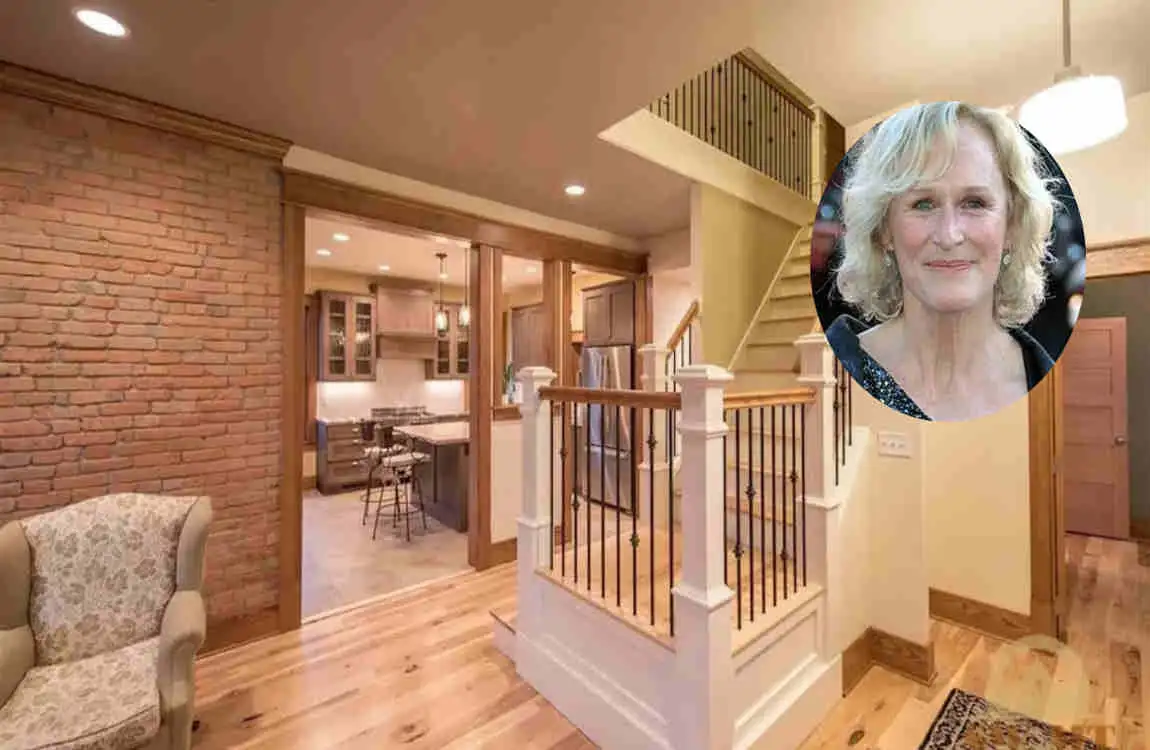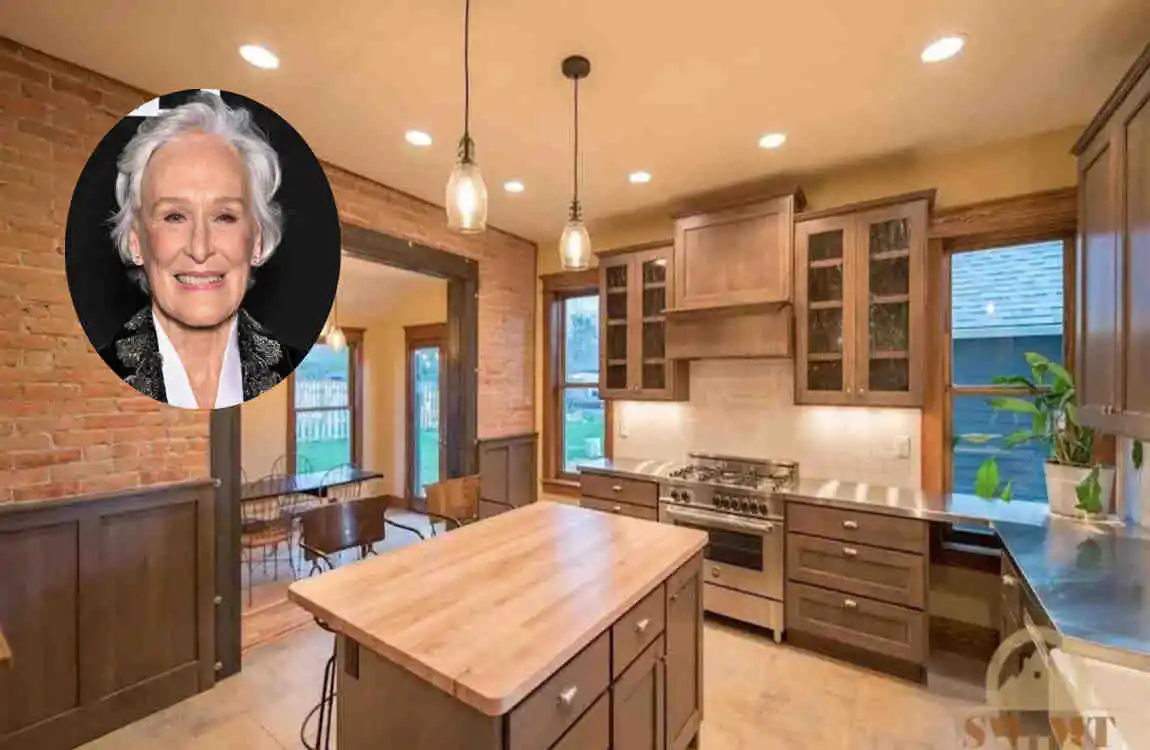Picture this: one of Hollywood’s most versatile and celebrated actresses trading the bright lights of Los Angeles for the rugged, untamed beauty of Montana’s wilderness. Glenn Close, known for her transformative roles and fierce dedication to privacy, has created something extraordinary in Big Sky Country. Her Montana retreat isn’t just another celebrity hideaway – it’s a masterclass in architectural harmony, where sophisticated design meets raw natural beauty.
Architectural Identity of the Glenn Close House in Montana

Design Philosophy and Style
The architectural style of Glenn Close’s Montana residence represents what designers call “refined rusticism” – a sophisticated interpretation of traditional mountain architecture. This isn’t your grandfather’s log cabin, though it pays homage to those pioneering structures. Instead, imagine clean lines softened by natural materials, where modern engineering enables expansive glass walls that would have been impossible in earlier eras.
The home’s design language speaks fluently in both contemporary and traditional dialects. Steep rooflines echo historic Montana lodges while managing snow loads with mathematical precision. Deep overhangs provide summer shade and winter weather protection, demonstrating how good design transcends style to embrace function.
Site-Specific Brilliance
Every great house begins with understanding its land. The Glenn Close Montana residence design shows masterful site analysis. Rather than imposing a predetermined plan, the architecture responds to topographical nuances. The structure follows natural contours, minimizing excavation while maximizing views.
Consider how the home addresses slope. Instead of fighting the terrain with massive retaining walls, the design embraces multiple levels that step gracefully down the hillside. Each level offers unique perspectives, from intimate forest views at lower elevations to panoramic mountain vistas from upper floors. This vertical journey becomes part of daily life, making movement through the home an experience of discovery.
Materials and Craftsmanship
The material palette deserves special attention. Montana moss rock, with its distinctive lichen patterns, anchors the structure visually and literally. These stones, gathered from local ranches, carry centuries of weathering that no manufactured material could replicate. Their irregular surfaces catch light differently throughout the day, creating an ever-changing facade.
Timber elements showcase the region’s forestry heritage. Douglas fir beams, some spanning impossible distances, demonstrate both engineering prowess and natural beauty. The wood’s grain patterns become artistic elements, carefully selected and positioned to create visual rhythm. Metal accents in weathered steel complement these organic materials, developing a protective patina that deepens with age.
Spatial Poetry
Inside, the Glenn Close house design in Montana reveals sophisticated spatial planning. Public areas flow seamlessly, encouraging gathering while maintaining distinct zones for different activities. The great room concept, essential in mountain homes, receives refined treatment here. Soaring ceilings create drama without overwhelming the human scale.
Private spaces offer contrast through intimacy. Bedrooms become cocoons, with lower ceilings and warmer materials creating psychological comfort. Transitional spaces – hallways, stairs, and landings – aren’t mere circulation routes but carefully choreographed experiences that build anticipation or provide pause.
The home’s circulation pattern respects both privacy and connection. Guest quarters maintain independence while remaining integrated with the whole. Service areas function efficiently without intruding on living spaces. This organizational clarity makes the home feel larger than its footprint suggests.
Interior Mastery and Living Experience
The Heart of the Home
Step inside, and you immediately understand why the Glenn Close house in Montana has garnered such attention. The entry sequence sets expectations perfectly. You don’t simply walk through a door; you transition between worlds. The foyer acts as a decompression chamber, where outside concerns fall away as Montana’s majesty reveals itself through strategically placed windows.
The main living area exemplifies what designers call “democratic space” – a space that welcomes all equally. The kitchen, no longer hidden away, becomes a social hub. Its professional-grade appliances satisfy serious cooks while maintaining residential warmth. Natural stone countertops echo exterior materials, creating visual continuity. Open shelving displays handcrafted pottery and local artisan work, celebrating regional craft traditions.
Dining as Theater
The dining space deserves special mention. Positioned to capture sunset views, it transforms meals into events. The table, likely custom-crafted from regional hardwood, anchors the space with substantial presence. Lighting design here proves particularly thoughtful – layered systems allow everything from bright family breakfasts to intimate candlelit dinners.
Consider how this space handles Montana’s dramatic seasonal changes. In winter, when darkness arrives early, warm lighting and a nearby fireplace create hygge-like comfort. Summer configurations might include opened glass walls that effectively double the dining area, extending onto terraces where mountain breezes provide natural cooling.
Sanctuary Spaces
The main suite in Glenn Close’s Montana residence represents privacy perfected. More than just a bedroom, it’s a complete retreat incorporating sleeping, lounging, and wellness areas. Floor-to-ceiling windows frame views like living paintings, changing with seasons and weather. Yet privacy remains paramount through careful siting and landscape screening.
The bathroom continues this luxury-meets-nature theme. Imagine soaking in a deep tub while watching snow fall on distant peaks. Natural stone surfaces provide durability and beauty, while radiant floor heating ensures comfort even on the coldest mornings. Double vanities crafted from regional materials maintain the home’s material consistency.
Light as Architecture
Natural light becomes an architectural material here. The design carefully orchestrates sunlight’s journey through spaces. Morning light floods eastern bedrooms, encouraging natural wake cycles. Clerestory windows in circulation areas provide ambient illumination without sacrificing privacy. The great room’s southern exposure maximizes winter solar gain while deep overhangs prevent summer overheating.
Artificial lighting receives equal attention. Instead of generic fixtures, you’ll find custom pieces that double as sculpture. Dimmers throughout allow infinite atmosphere adjustments. Task lighting in work areas ensures functionality without compromising ambiance. The overall effect makes spaces feel alive, responsive to both natural rhythms and human needs.
Climate Response and Comfort
Montana’s extreme climate demands sophisticated environmental controls. The Glenn Close house in Montana likely employs multiple heating strategies. Radiant floor systems provide even, comfortable heat without the drafts associated with forced air. High-efficiency fireplaces offer both practical warmth and psychological comfort – nothing beats a real fire on a winter evening.
Insulation strategies go beyond code requirements. Triple-pane windows with specialized coatings manage solar gain while maintaining views. Wall assemblies likely include advanced vapor barriers and thick insulation. These invisible systems ensure comfort while minimizing energy consumption, proving that sustainability needn’t sacrifice luxury.
Technology Integration
Modern mountain living demands modern conveniences. Smart home systems likely manage everything from lighting scenes to Security, all controllable remotely. Yet technology remains discretely integrated, never dominating the natural material palette. Speakers disappear into millwork, screens retract when not needed, and control panels hide behind artwork.
Outdoor Living and Landscape Integration

Extending the Living Space
The outdoor spaces of Glenn Close’s house in Montana deserve as much attention as the interiors. Covered terraces provide transitional zones between inside and out, allowing outdoor enjoyment even during Montana’s unpredictable weather. These spaces feature outdoor fireplaces or fire pits, extending usability into shoulder seasons.
Imagine morning coffee on a deck as mist rises from the valley below. Or evening gatherings around a fire pit, where conversations continue under star-filled skies, impossible in urban settings. These outdoor rooms receive the same design attention as interior spaces, with comfortable furnishings that withstand weather while maintaining style.
Native Landscape Philosophy
The landscaping philosophy embraces Montana’s natural beauty rather than imposing foreign aesthetics. Native grasses wave in the wind, requiring minimal irrigation while providing habitat for local wildlife. Wildflower meadows bloom in sequence, creating ever-changing color palettes that no formal garden could match.
This approach offers practical benefits beyond aesthetics. Native plants resist local pests and diseases, reducing maintenance needs. Deep-rooted species prevent erosion on slopes. The landscape becomes self-sustaining, requiring minimal intervention once established. This philosophy extends to hardscaping, where local stone paths and retaining walls echo natural rock formations.
Seasonal Adaptations
Montana’s dramatic seasons demand flexible outdoor spaces. Summer configurations might include outdoor kitchens and dining areas that handle large gatherings. Shade structures, whether architectural or natural, provide relief from intense mountain sun. Water features offer cooling sounds and visual interest.
Winter transforms these spaces differently. Snow management becomes crucial – roof designs shed snow safely, paths remain accessible, and structures withstand heavy loads. Yet winter outdoor spaces offer unique pleasures: hot tubs with mountain views, protected seating areas for après-ski gatherings, and fire features that extend outdoor seasons.
Sustainability, Craftsmanship, and Local Context
Building for the Future
Sustainability at the Glenn Close house in Montana goes beyond trendy green features to embrace holistic environmental thinking. The home likely achieves high energy efficiency through passive solar design, superior insulation, and efficient mechanical systems. But true sustainability means more – it means building structures that last generations, using materials that age gracefully, and creating spaces flexible enough for changing needs.
Water conservation proves particularly important in the Mountain West. Rainwater harvesting systems might feed irrigation needs, while low-flow fixtures reduce consumption without sacrificing comfort. Greywater recycling could nurture landscape areas. These systems work invisibly, maintaining luxury while respecting resource limitations.
Celebrating Local Craft
The construction of Glenn Close’s Montana home likely employed numerous local craftspeople, each bringing specialized skills. Timber framers who understand wood’s structural properties and aesthetic potential. Stone masons who can read rock grain and predict splitting patterns. Metalworkers who forge custom hardware that’s both functional and beautiful.
These artisans represent living traditions passed through generations. Their work connects the home to Montana’s cultural heritage in ways that imported materials never could. Supporting local craft also strengthens regional economies, creating a positive ripple effect throughout communities.
Cultural Resonance
The Glenn Close house in Montana’s sustainability extends to cultural preservation. By embracing regional building traditions while incorporating modern innovations, the home contributes to evolving architectural vocabulary. It demonstrates that contemporary comfort needn’t abandon historical wisdom.
This residence joins a tradition of thoughtful Montana architecture that includes historic lodges, working ranches, and earlier generation retreats. Each era adds layers to this narrative, creating rich architectural heritage. The home respects this continuum while adding its own chapter, proving that tradition and innovation can coexist beautifully.
Public Perception, Media Coverage, and Privacy
Balancing Curiosity and Respect
The public fascination with the Glenn Close Montana home reflects broader cultural interests in celebrity lifestyles and architectural excellence. Yet this attention requires careful navigation. Media coverage has generally respected boundaries, focusing on architectural merit rather than invasive details.
This restraint benefits everyone. It allows Glenn Close to maintain the privacy she sought in choosing Montana. It lets the architecture speak for itself without tabloid sensationalism. And it provides the public with genuine insights into thoughtful design rather than superficial glimpses.
Influence on Design Discourse
The Glenn Close house in Montana has influenced conversations about celebrity homes, mountain architecture, and sustainable luxury. Design professionals study the solutions to common challenges. Potential homeowners find inspiration in its balance of sophistication and authenticity. The home demonstrates that celebrity residences can make a meaningful contribution to architectural discourse.
Social media has amplified this influence, with images of Montana homes generating significant engagement. Yet the Glenn Close Montana home privacy remains largely intact, proving that public interest and personal boundaries can coexist. This balance offers lessons for how we discuss and share residential architecture in our connected age.
Setting New Standards
This residence has raised expectations for celebrity mountain homes. No longer can a massive log structure qualify as thoughtful design. The bar now includes environmental responsibility, cultural sensitivity, and architectural excellence. This elevated standard benefits everyone by encouraging better design across all residential projects.
Where Does Glenn Close Currently Live?
Glenn Close currently lives in Bozeman, Montana, where she has described her primary residence as a modest 1892 brick house and where she has said her siblings also live part of the time.
